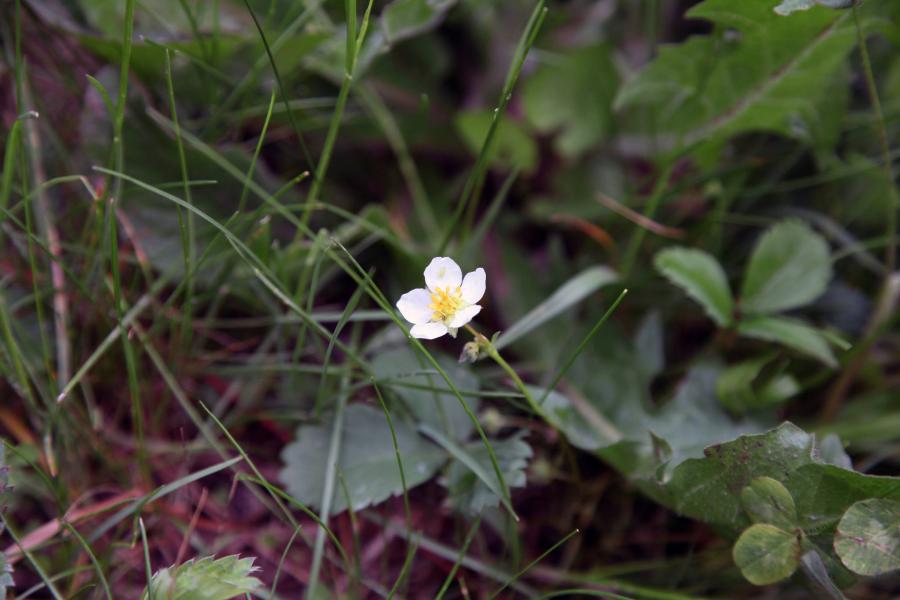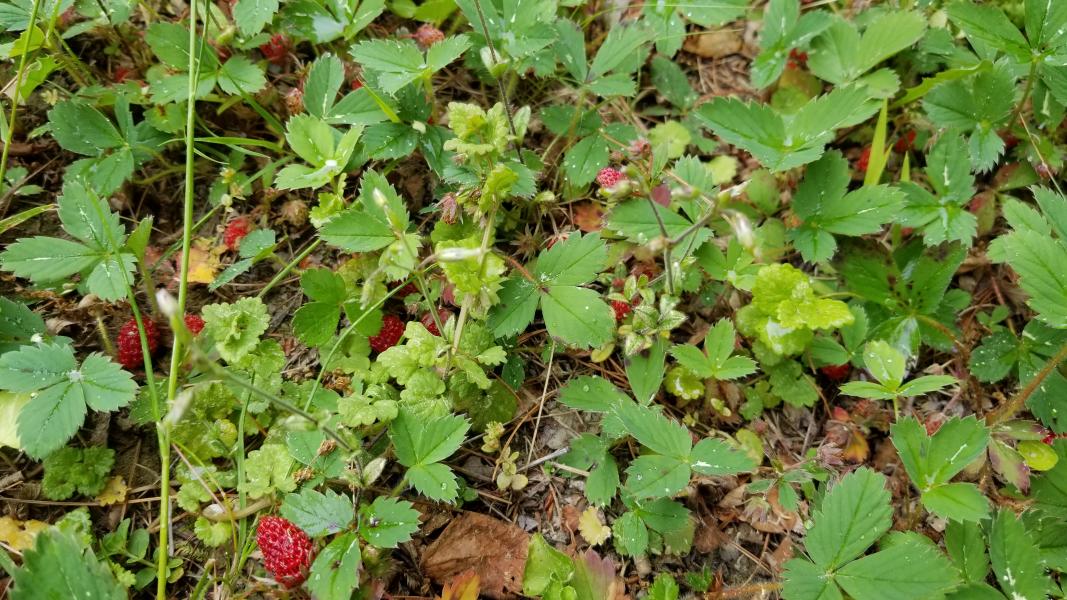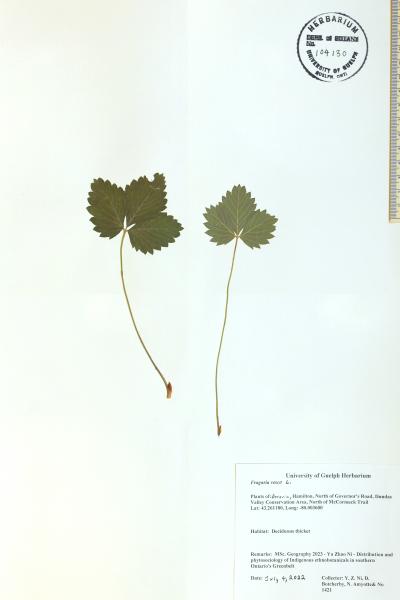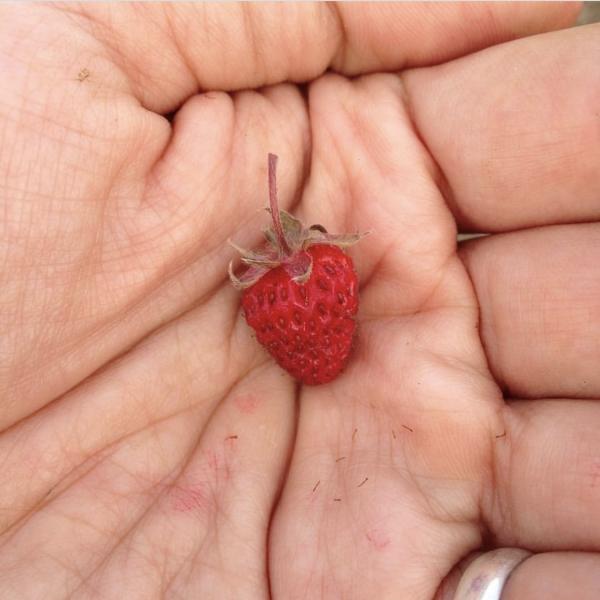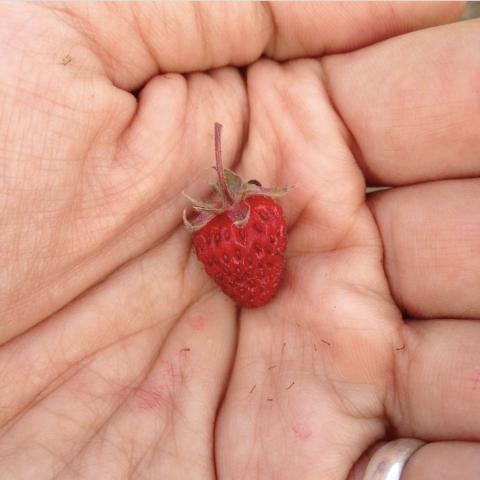
Names and Their Meanings
Wild Strawberry - Fragaria virginiana Duchesne
Woodland Strawberry - Fragaria vesca L.
Mock Strawberry - Potentilla indica Andrews (Th. Wolf)
Wild Strawberry
Description
A perennial, low growing herb with stems/red runners that trail along the ground. The leaves are attached to the stem by long hairy petioles, each bearing a single trifolate compound leaf (with 3 leaflets). The leaves are coarsely toothed along the margins, and hairy. Strawberries flower from April to July. The flower receptacle enlarges to form a red aggregate fruit, with seeds embedded in the skin. This Fragaria species is Native to North America. Wild strawberry occurs in fields, meadows, forest openings, forest edges, streambanks, lakeshores and disturbed grounds.
Conservation Status
S5 (Secure) in Ontario
Woodland Strawberry
Description
This woodland, wild strawberry is Native to the whole northern hemisphere, including Europe and Asia. It is very similar to the North American Native wild strawberry (F. virginiana), but there are a few notable morphological characteristics and habitat preferences that distinguish the two. F. vesca has seeds that stick out of the aggregate fleshy fruit, rather than being indented within the flesh. The leaflets are more sharply toothed, and the terminal teeth of each leaflet are longer than the next ones, rather than being slightly indented at the end. Fragaria vesca is more smooth than hairy, and it will grow in woodlands and conifer forests, while F. virginiana prefers the edge of deciduous forests and fields.
Conservation Status
No Recorded Rank on NatureServe in Ontario
Mock Strawberry
Description
We have included photos of the Mock Strawberry (Potentilla indica, syn. Duchesnea indica) because it is a strawberry look-alike. Mock strawberry is an exotic species that is not vulnerable, and grows throughout the east of North America, as well as in states and British Columbia, along the Western Coast of North America. Mock strawberries ARE edible, but very bland and not very tasty.
Uses
The Haudenosaunee call the tiny wild strawberry, “the leader of the berries,” because it is the first in the year to ripen. Strawberries are women's medicine, and processing them is traditionally women's work. Strawberries are enjoyed in strawberry drink, strawberry shortcake, and as dried fruits. Both the fruits and the leaves can be made into a tea that is a great nutritious tea, good for urinary tract, kidney, and women's reproductive health. Wild and woodland strawberries are very culturally important to the Haudenosaunee, the berries beloved for food, the leaves a woman's medicine.
Alyssa General recounted in a conversation with Jessica Dolan that one of the traditional stories around strawberries has to do with it being an anger medicine. As she was told (and she remembers it may be Martha Lickers from Akwesasne who she learned this from), “When a couple gets angry with each other and they keep walking in different directions, and the Creator drops things in front of them to ease their minds. Strawberries is one of the things, they give each other bowls of strawberries.”
In an Akwesasne community publication “Traditional Medicines,” it reads: “We give special acknowledgement to the strawberry as being leader of all plants.” It recounts that the leaves are used as a diuretic, for urinary disorders, fever, weakened body, and a good source of calcium; the roots are used for intestinal weakness and a blood purifier; the berries for kidney and bladder problems, gout, toothache, and skin irritations. Cayuga nutritionist Terri Morrow writes that Wild Strawberries offer great benefits of high vitamin C, and they keep the blood healthy and strong; she describes a traditional teaching around strawberries is that of appreciating the work it takes to harvest food, and how food options are abundantly found all around us – even growing in patches just outside the home. Anishinaabe call strawberries “Heart Berries,” due to their shape and their spiritual and ceremonial strength in nourishing the heart. Ojibwe ethnobotanist Scott Herron describes similar uses among the Ojibwe of strawberries as food and medicine.
Frederick Wilkerson Waugh recorded numerous uses for wild strawberries in his studies of Haudenosaunee and Anishinaabe cultures. In 1911 and 1912, when Waugh interviewed Chief John Arthur Gibson and others about traditional foods, they described using wild strawberries as food and a dye source, as a ceremonial drink. His notes contain references to several varieties of wild strawberries that grew at Six Nations that were food sources, including wood strawberries. Beauchamp noted Haudenosaunee ecological knowledge of the strawberry is that they thrive where the ground has been burned.
In an interview with Seneca Elder Sadie Buck from Six Nations of the Grand River, Sadie described relationships with strawberries, the strawberry ceremony, and Mother Earth as follows:
JD: Do you believe that ceremony or other spiritual practice supports Mother Earth?
SB: Well our ceremonies, that's what they are for. To show our appreciation for the earth, so that all of the elements continue to do what they are supposed to do, be thankful to the Creator and that this is ongoing. And, you know, like so when we have strawberry dance we are thankful the Creator for the strawberries as representative of all the fruit, all the hanging fruit. So then, but not just for us, like you know, we are not excluding the strawberries growing in China or California, or Venezuela, you know, wherever a strawberry is. So our ceremonies are taking care of the whole of the earth, not just our portion. So it's a, when we work to maintain our ceremonies, we are maintaining it for all of human kind.
Seneca community educator Yvonne Thomas recounted to Dr. Dolan the teachings shared with her and by her late husband, Cayuga Chief Jacob Thomas, that strawberries line the path back to the Skyworld, once a person has passed away. In the Creation story, as recounted by many and the ethnobotany of which has been discussed by Mohawk scholar Amber Adams, Skywoman grasped at the edge of the hole, and tiny strawberry seeds mixed with the dirt under her fingernails; strawberries came down to Turtle Island with her, and were therefore among the first food plants that grew on Turtle Island. It makes sense that, if wild strawberries came down from Skyworld with Skywoman, then they line the pathway back.
